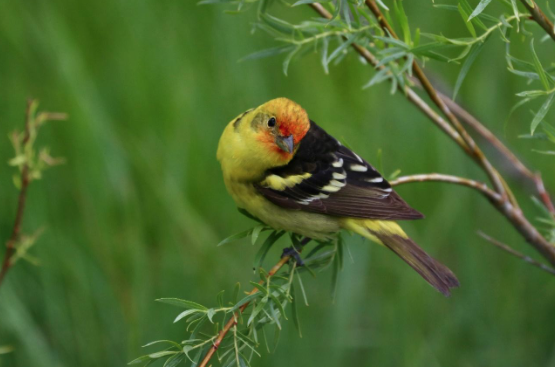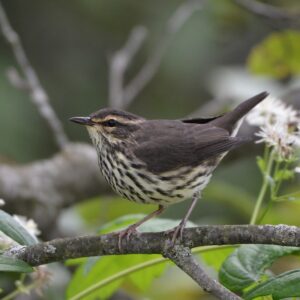Get To Know This Year’s Featured World Migratory Bird Day Species: Western Tanager

VITAL SIGNS
- Common name: Western Tanager
- Latin name: Piranga ludoviciana
- Range: Located mainly in Western North America
- Lifespan: Average lifespan of 8 years2
- Size: Range in length from 16 to 19 cm, with a wingspan ranging from 28 to 30cm2
- Population estimate: 500,000 to 5,000,000 in Canada1.
THE FACTS
The Western Tanagers are commonly found in open coniferous forests and mixed woodlands2. They are found in elevations ranging between 100 and 3050 metres2. Despite being found in a large range of elevations, the species flies only at very high altitudes. High populations of western tanagers have been found in areas with high numbers of Douglas-fir trees due to the high amount that are found in old-growth forests, which are the favoured breeding habitat of Western Tanagers1. The Western Tanager migrates long distances, either individually, in pairs, or in groups of 30! Often they migrate only at night2. Night migration is surprisingly common for many bird species, as it allows them to avoid predators and provides a cooler environment for travelling. The theme of this year’s World Migratory Bird Day is “Dim the lights for Birds at Night!” which will help to spread awareness about the negative effects of light pollution on migratory birds.
The diet of the Western Tanager mainly consists of insects such as wasps, ants, termites, cicadas, beetles, and grasshoppers2. They are also known to snack on fruits such as elderberries, blackberries, mulberries, and hawthorn.
The Western Tanager gets its red pigment from a chemical called rhodoxanthin, which is obtained from their diet3. This red pigment is seen on the heads of male birds, who are much more colourful than their female counterparts!
THE STORY
Western Tanager populations have been on the rise since 1966 and have a ‘Secure’ population according to the Cornell Lab. However, they are still considered At-Risk due to an increase in development and urbanization in Canada. The Western Tanager has been shown to favour habitats with older growth trees1. The destruction of old-growth forests, particularly the ones in Western Canada, negatively impacts the species’ population abundance. Old-growth forests are being chopped down at worrying rates, putting over 2000 species, including the Western Tanagers, at risk.
WHAT IS BEING DONE
The Western Tanager was designated as a species of “least concern” by the International Union for the Conservation of Nature in 20121. In a 2010 Wild Species Canada report, the population was listed as ecure1. It was also designated a Priority Species in the Boreal Taiga Plains and Northern Rockies regions of the Bird Conservation Region Strategy1.
WHAT YOU CAN DO
Advocating for the conservation of old-growth habitats in Canada, and the advocation for the conservation of forests, in general, is a great way to support the Western Tanager.
You can also get involved with a local Bird Team in your community to work towards becoming Bird Friendly City Certified or host and participate in an upcoming World Migratory Bird Day event near you!
- 1Status of Migratory Birds in Canada: Western Tanager. 2014. Government of Canada https://wildlife-species.canada.ca/bird-status/oiseau-bird-eng.aspx?sY=2014&sL=e&sM=c&sB=WETA
- 2Boles, J. 2014. Piranga ludoviciana, Animal Diversity Web. https://animaldiversity.org/accounts/Piranga_ludoviciana/
- 3The Cornell Lab, 2019. All About Birds: Western Tanagerhttps://www.allaboutbirds.org/guide/Western_Tanager/overview
- 4Wilson, H. 2011. Nocturnal Migration, Colby College. https://web.colby.edu/mainebirds/2011/11/09/nocturnal-migration/



